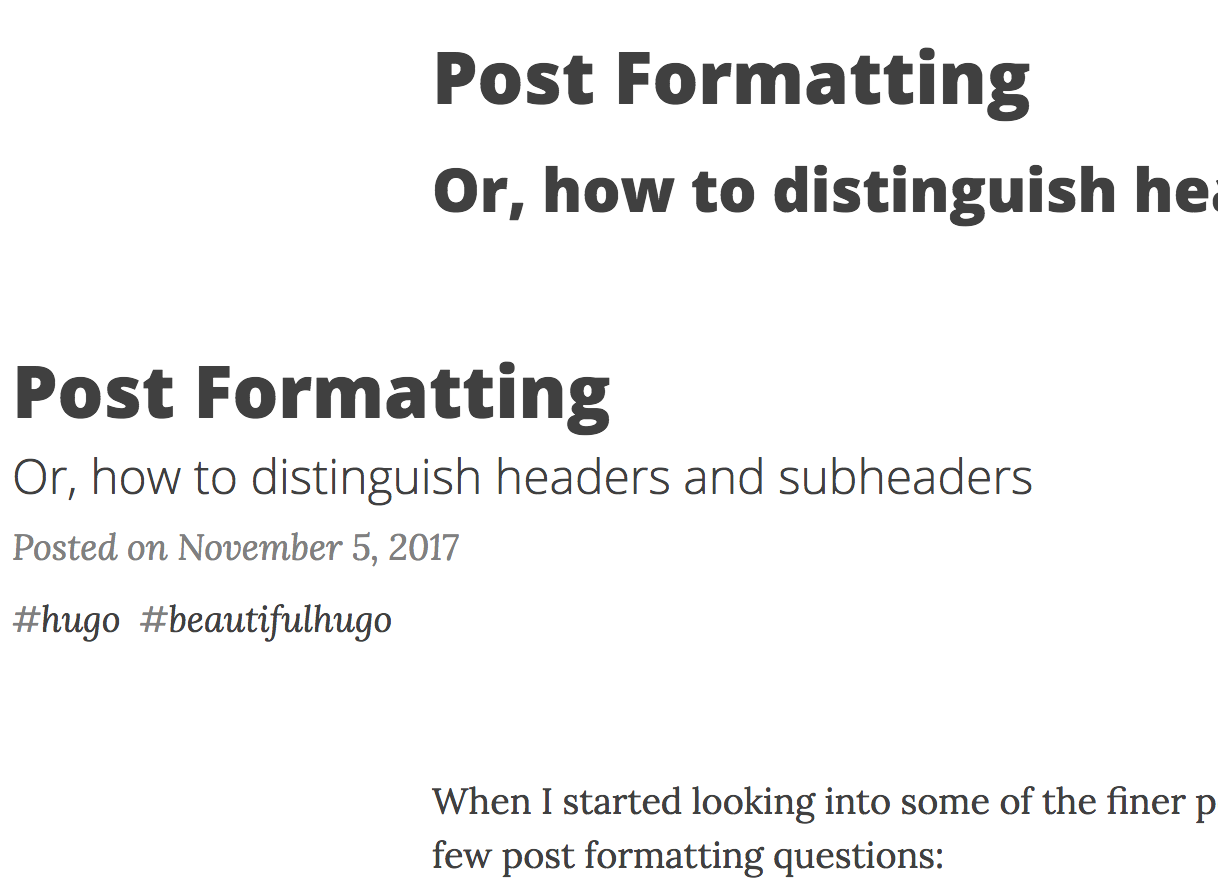When I started looking into some of the finer points of how my Hugo site looked, I had a few post formatting questions:
- Why does the sub-header look different in the post listing and page view?
- Why do the date posted and tags not appear in the page view but do in the post listing?
First, to the Docs!
As has been helpful on a number of occasions, I went to the Hugo docs to
see if I could find what I needed there. I started with
singe page templates
which led me to themes/beautifulhugo/layouts/_default/single.html.
Looking in that file, I didn’t quite see what I was looking for.
|
|
Instead of something as simple as {{ .Content }} I was looking to find
something that resembled more of what I was seeing in
themes/beautifulhugo/layouts/_default/list.html.
|
|
In particular, I was looking for something that called out the following elements:
{{ .Title }}{{ .Params.subtitle }}{{ i18n "postedOnDate" }}{{ .Params.tags }}
Custom layouts/posts/single.html
NOTE: In the header, I use “posts” instead of “post” - I thought I
remembered seeing something about using singular in some places and
plural in others but in the end, in order for this to take effect I
needed the directory in layout/ to match the name of the directory
in content/.
My first attempt to inject what I was looking for into the single.html
was to insert something between <div class="container" role="main">
and <div class="row"> (the first and last rows in the code below).
I used what I had seen in the list.html as a reference.
|
|
I should have realized this wouldn’t work because even the single.html
that I was starting from did not include the {{ .Title }} and other
elements. What I did get was something like the following:
But I did learn that what I was looking for was something that
apparently wraps the single.html partial.
A Break, Then A Breakthrough
I took a break from digging into this topic. It felt like a time-sink that I wasn’t likely to break out of any time soon.
When I came back at it, it was after I had been digging into the Pygments to Chroma Migration and was thinking more about CSS as a result.
As it turns out adding the following two lines to the main.css from
the theme addressed the sub-header font weight issues I was seeing.
|
|
This seems to be because of a typo in either the theme or in Hugo.
The following block shows what I think was supposed to address this
issue of changing the font-weight: 800 to font-weight: 300 for
sub-headings but they use the singular instead of plural for both
post and page.
|
|
My guess is that it is a problem in the
BeautifulHugo theme
since I couldn’t find subheading in the
Hugo repo but I was able to
find it in the theme’s repo.
I created a new issue
to see if what I found could be confirmed or refuted. (Keep reading,
turns out I was wrong… mostly.)
Just One More Thing To Check
I should have gone to bed. But instead, I took one more pass down a line of thinking I had been going on before I took that long break. I needed to look at how Content Types are defined in Hugo.
Spoiler: back in the “Custom layouts/posts/single.html” section I
made a note about singular vs plural issues.
When you look closely at the Content Types documentation it says that types are always singular when creating a Type layout directory. By contrast in the Assign a Content Type section it gives examples using the plural.
This apparent guidance - to use posts instead of post - conflicts
with what the Beautiful Hugo theme expects. Renaming my content/posts/
directory to content/post/ allowed me to remove the custom main.css
I had made to compensate for this percieved bug in the theme. Feeling
a bit sheepish, I updated and closed the issue I had created ~2h earlier.
Update: Later I also “fixed” the formatting on the “About” page by moving
content/pages/ to `content/page/'.
When I resolved this conflicting type issue, I also found that the
date posted was now showing at the top of the posts! That led me to
noticing that there is a post_meta.html
partial that is
referenced
in both layouts/partials/header.html and layouts/index.html in the
theme.
At first, I tried adding the tags to the post_meta.html but ultimately
ran into issues where tags would show up twice on the main post listing.
Instead I found that if I replace two blocks that looked like the
following in header.html:
|
|
With something like the following which adds in the tags conditionally:
|
|
That got me what I was looking for.
But then I noticed that the Posts page wasn’t using the same
formatting I would be expecting from post_meta.html. I looked at
layouts/_default/list.html in the theme and found that it had the
following:
|
|
Instead of what I would be expecting:
|
|
Making that change in a copy of layouts/_default/list.html did the
trick.
I’m wondering if sending a PR to fix that will be my first contribution to the theme. Right now - 2:30 AM - I need to get some sleep because I have “kid duty” in about 4 hours.
Update: Because I can’t seem to leave well enough alone tonight, I did create the PR. :)
